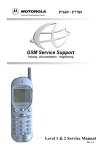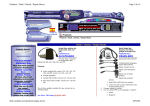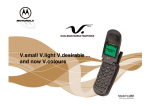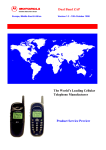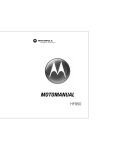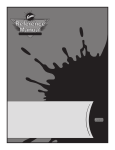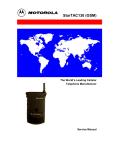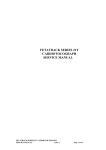Download Level III Service Manual
Transcript
V3682 Level III Service Manual Single Band 1900 MHz GSM V3682 CONTENTS Page Number SECTION 1: GENERAL 1.1 1.2 1.3 Introduction Motorola service policy for V3682 in warranty General Safety Information v vi vii SECTION 2: V3682 DESCRIPTION 2.1 2.2 2.3 2.4 Specifications of V3682 V3682 Overview Connector Pinout Talk time, Weight and Volume Matrix 2 3 4 4 SECTION 3: FEATURE LIST 3.1 List of Features available 6 3.2 3.3 3.4 3.5 3.6 3.7 3.8 3.9 Menu Phone Book Call Related Features Messages Phone Set Up Network selection Call Meters Accessory set-up 6 7 7 8 9 10 10 11 SECTION 4: DISASSEMBLY & PARTS 4.1 4.2 4.3 4.4 4.5 4.6 Dissasembly Introduction Recommended Tools Disassembly Procedure Assembly procedure Exploded Parts diagram Replacement parts 13 13 13 13 16 17 SECTION 5: SIM CARDS AND SECURITY 5.1 5.2 5.3 5.4 5.5 Manual test mode Live Sim Card Personality Transfer GSM Test Command Identity and Security 19 19 19 21 22 SECTION 6: REPAIR & TEST PROCEDURES 6.1 6.2 6.3 6.4 ii of 46 Repair introduction Mechanical repairs Basic modular troubleshooting Software Upgrade European Customer Services 24 24 24 27 V3682 6.5 6.6 6.7 6.8 Flexing Testing on HP 8922 Testing PCB only on Car Kit Set Up Testing on Go / NoGo Tester 27 28 29 30 SECTION 7: ACCESSORIES 7.1 Accessory Statement 32 SECTION 8: GLOSSARY OF TERMS 8.1 iii of 46 List of Abbreviations 35 European Customer Services V3682 SECTION 1: GENERAL iv of 46 European Customer Services V3682 1.1 Introduction This manual is intended for use by technicians familiar with similar types of equipment. It contains all service information required for the equipment described and is current as of the printing date. The scope of this document is to provide the reader with basic information relating to the V3682, and also to provide procedures and processes for repairing the units up to and including Level 2 repair. Level 1 and 2 repairs involve the following activities to be carried out: • • • • • • • 1.Unit swap out 2.Repairing of mechanical faults 3.Basic modular troubleshooting 4.Testing and verification of unit functionality 5.Upgrading software 6.Flexing units 7.Initiate warranty claims and send faulty modules to Level 3 or 4 repair centres. Computer Software Copyrights The Motorola products described in this instruction manual may include copyrighted Motorola computer programs stored in semi-conductor memories or other media. Laws in the United States and other countries preserve for Motorola certain exclusive rights for copyrighted computer programs, including the exclusive right to copy or reproduce in any form the copyrighted computer program. Accordingly, any copyrighted Motorola computer programs contained in the Motorola products described in this instruction manual may not be copied or reproduced in any manner without the express written permission of Motorola. Furthermore, the purchase of Motorola products shall not be deemed to grant either directly or by implication, estoppel, or otherwise, any license under the copyrights, patents or patent applications of Motorola, except for the normal non-exclusive, royalty free license to use that arises by operation of law in the sale of a product. v of 46 European Customer Services V3682 1.2 Motorola Service Policy for V3682 in warranty 1.2.1 Warranty: Product will be sold with the standard 12 months warranty terms and conditions. Accidental damage, misuse, and retailers extended warranties will not be supported under warranty. Non warranty repairs will be available at agreed fixed repair prices. Refer to the latest version of CSB 235 for details. Proof of purchase will be required to validate warranty claims. 1.2.2 Out of Box Failure Policy Refer to the latest version of CSB 270 for the definition of Out of Box Failures, and for specific instructions. 1.2.3 Product Support Customers original units will be repaired but not refurbished as standard. Level I shops may replace accessories and Level I parts; Level II shops may replace non-soldered parts; Level III shops may perform some board level repairs. The U.S. National Service Center makes all repairs. 1.2.4 Customer Support: Consumers should call 1 - 800 331 - 6456. Motorola Warranty Authorized Service Centers should call 1 - 877 777 - 7520 55# for access to Technical Support. 1.2.5 Replacement Parts Ordering Only shops authorized to carry out repairs will be able to purchase spare parts. Orders for spare parts should be placed with the Accessories and Aftermarket Division (AAD) of Motorola. Refer to the latest version of CSB 260 for details. vi of 46 European Customer Services V3682 1.3 General Safety Information 1.3.1 Portable Operation • DO NOT hold the radio so that the antenna is very close to, or touching, exposed parts of the body, especially the face or eyes whilst transmitting. The radio will perform best if it is held in the same manner as you would hold a ‘land’ telephone handset, with the antenna angled up and over your shoulder. • DO NOT operate the portable phone in an aircraft. Switch off your telephone. The use of a cellular telephone in an aircraft may be dangerous to the operation of the aircraft, disruption of the Cellular Network may occur, and is illegal. Failure to observe this instruction may lead to a suspension or denial of Cellular Telephone Service to the offender, or legal action, or both. 1.3.2 Mobile/Portable Operation - Telephone use in Vehicles: • All equipment must be properly grounded according to installation instructions for safe operation. • Users are advised to turn off their equipment when at a refueling point. • Safety is every driver’s responsibility. Cellular telephones should only be used in situations in which the driver considers it safe to do so. 1.3.3 General • DO NOT allow children to play with any radio equipment containing a transmitter. • DO NOT operate this equipment near electrical blasting caps or in an explosive atmosphere. Mobile Telephones are, under certain conditions, capable of interfering with blasting operations. When you are in the vicinity of such work, look out for and observe signs cautioning against mobile radio transmission. If transmission is prohibited, you must turn off your mobile telephone to prevent any transmission. In standby mode the mobile telephone will automatically transmit to acknowledge a call if it is not turned off. • Refer to the appropriate section of the product user manual for additional pertinent safety information • All equipment should be serviced only by a Motorola qualified technician. vii of 46 European Customer Services V3682 SECTION 2: V3682 DESCRIPTION 1 of 46 European Customer Services V3682 2.1 Specifications of V3682 General Function Frequency Range GSM PCS 1850.2 - 1909.8 MHz Tx 1930.2 - 1989.8 MHz Rx Channel Spacing Channels Modulation Transmitter Phase Accuracy Duplex Spacing Frequency Stability Operating Voltage 200 kHz 174 GSM/374 DCS carriers with 8 channels per carrier GMSK at BT = 0.3 5 Degrees RMS, 20 Degrees peak 45 MHz GSM 95Mhz DCS + 0.10 ppm of the downlink frequency (Rx) +3.0V dc to +5.1V dc (battery) +4.4V dc to +6.5V dc (external connector) Typically 225 ma avg, 1.1A peak Typically 7.5 ma (DRX2) 82mm(L) X 43mm(W) X 26mm(H) 72 cc 83 g -10C to +55C Transmit Current Stand-by Current Dimensions Size (Volume) Weight Temperature Range Transmitter Function RF Power Output Output Impedance Spurious Emissions Receiver Function RF Level RX bit error rate (100 k bits) Channel Hop Time Time to Camp Speech Coding Function Speech Coding Type Bit Rate Frame Duration Block Length Classes Bit Rate with FEC Encoding 2 Specification of 46 Specification 33 dBm + 2dB GSM/ 30 dBm + 2 dB DCS 50 ohms (nominal) -36 dBm from 0.1 to 1 Ghz -30 dBm from 1 to 4 Ghz Specification -102 dBm < 2% 500 microseconds Approximately 5-10 seconds Specification Regular Pulse Excitation / Linear Predictive Coding with Long Term Prediction. (RPE LPC with LTP). 13.0 k bps 20 ms 260 bits Class 1 bits = 182 bits. Class 2 bits = 78 bits 22.8 k bps European Customer Services V3682 2.2 V3682 Overview The V3682 has been marketed as the lightest and smallest dual band mobile phone in the world. It is now designed with the new Whitecap Chipset to allow the unit to operate at a lower working voltage and therefore prolong battery life, in both Standby and Talk time. The holographic display is now fitted into the flip to allow more room on the keypad. This product is a replacement for Startac 130 and its main features include: • Smaller and more stylish form • Single Band 1900 MHz GSM • Longer Talk time / Standby time • Large bit mapped 96 X 54 display with 1 line of Icons and Optimax holographic display • Class II Sim tool kit • Internal headset • Potential to support Half Rate and Enhanced Full Rate modes of transmission (dependant on Network) • Asian SMS • Asian Phonebook. • Extended GSM The units will be made of a Polycarbonate plastic with the display and speaker fitted within the flip. The bottom part of the clam will contain the keypad the LOGIC / RF PCB, the Mic, earpiece flex connection, external accessory connector and volume buttons. There will be two types of battery doors available each to fit the standard and long life batteries, the phone accepts a 3V or 5V mini SIM card which fits into the SIM slot underneath the battery. There will be no connection or fitting for an Auxiliary battery. The Antenna is usually a fixed stub type antenna. The Service indicator will as for other Startac products display a Green light whilst in service, a Red light whilst out of service and will flash Amber when roaming. Fig 2.1 Mechanical pictorial Overview Headset Jack Socket Speaker Holographic Display Flip Vol. up Service Indicator Mute button Antenna Keypad Smart Key Batt Door Release IMEI & MSN Label Battery Contacts Vol. Down 3 of 46 SIM Contacts European Customer Services Accessory Connector V3682 2.3 Connector Pinout 15 1 123456789101112131415- 2.4 RF Ground RF In/Out RF Ground Battery Feedback Manual Test Line Not connected Not Connected Audio In Audio Out / On-Off Battery Ground RTN CMP TRU External B+ Analogue Ground Talk Times, Weight and Volume Matrix ✸ White holographic film on display Weight Talk Time Standby time (grams) (minutes) (hours) Volume (cubic cm) TBD 69 69 80 53 72 77 92 100-130 130-160 260-330 70-125 95-160 190-320 TBD TBD TBD TBD 4 of 46 Name Transceiver Only Transceiver with 400 mAh LI Slim Batt Transceiver with 520 mAh LI Slim Batt Transceiver with 1000mAh Extended capacity battery Transceiver with 200mAh high performance battery European Customer Services V3682 SECTION 3: FEATURE LIST 5 of 46 European Customer Services V3682 3.1 List of Features Available Below are the list of Menu functions available at present, all highlighted text are or menu options that may be added in future versions i.e. on the release of Voice Annotation. Below are the list of Menu functions available at present, all highlighted text are or menu options that may be added in future versions i.e. on the release of Voice Annotation. Menu 1st Generation Menu Phone Book Network Selection Call Related Features Call Meters Messages Phone Setup 2nd Generation Menu 3rd Generation Menu 4th Generation Menu Th Generation Menu 6th Generation Menu Only Available with Headset or Car Kit connected Accessory Setup PHONE BOOK Personal Numbers 1.Last Calls made 2.Last calls received 3.Erase all numbers Last 10 Calls Find Entry by Name Enter Name Find Entry By Location Enter Location Add Entry 1.Add to Phone memory 2.Add to SIM card memory 1.Call Number 2.Modify Name or number 3.Erase name or number My phone number(s) Fixed dialing View fixed dial list Setup fixed Dialing 1.On 2.Off 3.Edit Entry 4.Add Entry 5.Erase Entry Check Capacity Prevent access 1.To Phone memory 2.To SIM memory 3.To Fixed Dial list One-Touch Dial Setting 6 Enter Pin2 of 46 European Customer Services 1.Check phone Capacity 2.Check SIM capacity 1.No memory restrictions 2.To SIM card memory 3.To phone memory 4.To phone and SIM memory V3682 CALL RELATED FEATURES Show battery meter Restrict my Phone number 1.Show ID on next call 2.Restrict ID on next call Call Diverting Talk and Fax 1.On 2.Off Call waiting 1.On 2.Off Call Barring Bar outgoing calls 1.Int’l Calls 2.Int’l Calls Except home 3.All Calls 4.Off Bar Incoming Calls 1.When Roaming 2.All Calls 3.Off Change Bar password Cancel all barring Divert Voice calls Divert Fax Calls Divert Data Calls 1.On 2.Off 1.On 2.Off Divert when unavailable 1.On 2.Off Divert all Voice calls 1.On 2.Off Detailed Diverting If Busy 1.On 2.Off Cancel all diverting If not reachable If No Answer 7 of 46 European Customer Services 1.On 2.Off 1.On 2.Off V3682 Messages Call Voicemail Received messages Go to Next message Delete Message Return Call Edit Message 1.Send Message 2.Store Message Reply to message Delete all messages Outgoing Messages Go to next message Send message Edit message Delete message 8 of 46 Cell broadcast 1.On 2.Off Message Settings 1.Voicemail Number 2.Service Centre 3.Expiry Period 4.Outgoing message type European Customer Services 1.Send message 2.Store message V3682 PHONE SETUP Select Phone line Adjust Ring volume Ring or Vibrate 1.Ring only 2.Vibrate only 3.Vibrate then ring 4.No ring or vibrate Set Ringer Tone Standard Tone . . Music Tone Set Ringer Tone 2 Phone Lock Automatic Lock Adjust Contrast Lock Now Change SIM PIN mode Require SIM card pin 1.On 2.Off 3.Change SIM pin Code New security code Extended menus 1.On 2.Off Show time and Date Set Time and Date Set Time format 9 of 46 Language Selection English . . Automatic Battery saving mode 1.On 2.Off Select Keypad tones 1.Normal Tones 2.Single Tones 3.No Tones Phone Status 1.Status review 2.Master reset 3.Master Clear European Customer Services 1.On 2.Off V3682 NETWORK SELECTION Available Networks 1.Register Now 2.Make Preferred Network Search Registration Preferences 1.Automatic Search 2.Manual Search Frequency of Search 1.Slow Search 2.Medium Search 3.Fast Search 4.Continuous Search Add network to List 1.Choose From Available 2.Choose From Known 3.Add new Network Code Preferred Networks 1.Move to New Location 2.Delete Selection CALL METERS Show Call charges 1.Show last call 2.Total for all calls 3.Credit remaining Show call timers 1.Show last call 2.Total for all calls 3.Reset all timers Set audible Call Timers Single Alert Timer 1.On 2.Off Repetitive Timer 1.On 2.Off Set in call Display 1.Show time per call 2.Show Charge per call 3.Show total Call charges 4.No in call display Call charge settings Reset Call charges Set Total Charge Limit Set Charge Type 10 of 46 European Customer Services 1.On 2.Off 1.Units 2.Currency V3682 ACCESSORY SETUP NB. THIS MENU IS ONLY AVAILABLE WITH EITHER HEADSET PLUGGED IN OR WHEN INSTALLED IN A CAR KIT. Mute Car Radio 1.On 2.Off Automatic answer 1.On 2.Off Automatic Handsfree 1.On 2.Off Safety Timer 1.On 2.Off Auxiliary Alert 1.On 2.Off 11 of 46 Dependant on type of car kit European Customer Services V3682 SECTION 4: DISASSEMBLY & PARTS 12 of 46 European Customer Services V3682 4.1 Disassembly Introduction The V3682 has no screws to hold it together and is held together by plastic catches, these are delicate and should be parted using the upmost care. Also the display flex cable can be torn or broken without too much stress being applied so again caution should be taken on dissassembly or assembly. Ensure that a properly grounded high impedance conductive wrist strap is used whilst performing any tasks during the disassembly and assembly of the unit Avoid stressing the plastics in any way to avoid damage to either the plastics or internal components. !! CAUTION !! Many of the intergrated devices used in this equipment are vulnerable to damage from electro-static charges. Ensure that adequate static protection is in place when handling, shipping and servicing the internal components of this equipment. 4.2 Recommended Tools The following tools are recommended for use during the assembly / disassembly of the V3682. • Anti-static Mat Kit - 0180386A82, includes: Antistatic mat 66-80387A95 Ground Cord 66-80334B36 Wrist Band 42-80385A59 • Plastic Bladed Tool SLN7223A 4.3 Disassembly Procedure The following set of diagrams will demonstrate the correct sequence and action required to disassemble the V3682 The use of the exploded diagram on page 18 may be of some assistance for part recognition. 4.4 Assembly Procedure Once the unit is disassembled and the repair is carried out, the unit must then be reassembled, this is carried out in the exact reverse order as the disassembly. 13 of 46 European Customer Services V3682 1.Remove Battery door by pressing up on latch and pulling door. 4.Remove the LED Indicator 14 of 46 2.Remove the battery from pushing from the bottom and lifting outwards. 3.Push down on Antenna and screw Antenna Anticlockwise. 5.Push tool between latch and housing to prize open European Customer Services V3682 7.Carefully lift the retaining clip on the flex connector. Then pull the flex from the connector. 6.Remove with care the backhousing from the front. Remove keypad PCB from board 8.Lift PCB out of front housing 15 of 46 European Customer Services V3682 4.5 Exploded Parts Diagram SWF3076DA 1 4 2 3 8 5 6 7 10 11 9 15 14 16 of 46 16 European Customer Services 12 13 V3682 4.6 Replacement Parts Xcvr Item Number Spare Xcvr Number Rear Hsng Hinge Mechanism Frnt Hsng Assy Flip Assy Keypad PCB Keypad SW Array Domes Escutcheon Lens Mic grommet Mic 6mm Light Guide Antenna Insert Stubby Antenna Batt Door 17 of 46 1 2 3 4 5 6 7 8 9 10 11 12 13 14 15 16 SWF3076DA SE0044AB1Z1 0104793Z01 5504765Z02 0104792Z01 0185763G01 SYN6939A 3809378T02 4004877Z02 5403796S01 6185833G02 0585699J01 5009135L07 6185635H02 4385988H01 0185829G02 SYN 7117B European Customer Services V3682 SECTION 5: SIM CARDS AND SECURITY 18 of 46 European Customer Services V3682 5.1 Manual Test Mode The GSM Motorola V3682 is equipped with a manual test mode capability. This capability allows service personnel to take control of the unit, and by entering certain keypad commands, make the unit performs desired functions. To enter the manual test command mode, a GSM / DCS test sim (Part No 8102430Z01) must be used. The test sim is inserted into the SIM slot beneath the battery (See figure 6.1), the battery should then be re-inserted and the unit powered on. The # button should then be pressed for approximatly 3 second until ‘test’ appears on the display, and the correct commands must then be followed. Figure 6.1 SIM Card insertion 5.2 Live Sim Card A SIM (Subscriber Identity module) card will be required to access the existing local GSM / DCS cellular network, or remote networks when travelling. (If the roaming agreement has been made with the provider.) The SIM card contains all the data necessary to access GSM services, and also: • The ability to store user information such as phone numbers etc… • All information required by the network provider to provide use to the network 5.3 Personality Transfer 5.3.1 Introduction Personality Transfers are required when a phone is Express Exchanged or when the main board is replaced. The reason for personality transfers are to reproduce the customer’s original personalized details such as menu and stored memory such as phone books etc… or even just to program a unit with basic user information such as language selection. There are two possible methods of transferring this information from unit to unit, or with a master transfer, card to unit: • Normal Transfer is used when the customer’s original unit still powers up and as discussed above the customers personalized menu selections etc… are required to be transferred to the replacement unit. • Master Transfer is used when the faulty unit will not power up and the transfer is used to configure the replacement board to a set standard. Below is the procedure to set up a Master Transfer Card and to carry out each method of transfer correctly. 5.3.2 Normal Transfer 1. 2. 3. Insert transfer card into ‘Donor’ Unit. Turn unit on till ‘Clone’ appears. Enter 021# to upload first block of data. ‘Please wait’ will be displayed.. Remove card. 19 of 46 European Customer Services V3682 4. 5. 6. 7. 8. Insert card into replacement unit, or unit with new main RF / Logic PCB. Turn unit on wait till ‘Clone’ appears. Enter 03# ‘Please wait’ will be displayed while data is transferred. Repeat steps 1 – 6 but enter 022# at step 2 to transfer data on to Clone card. Repeat steps 1 – 6 but enter 025# at step 2 to transfer data on to Clone card. 5.3.3 Master SIM Card Creation 1. 2. Insert transfer card into a unit with the desired setup Pwr on and wait till unit displays ‘Clone’ Enter 024# to copy unit ‘personality’ onto card. ‘Please wait’ will be displayed 3. Master Transfer card is created. 5.3.4 1. Master Transfer 2. 3. Insert Master Transfer Card (explained above) into replacement unit. Pwr on and wait till unit displays ‘Clone’ Enter 03# to download data into replacement unit. Please wait will be displayed. When ‘Clone’ reappears download is completed. 20 of 46 European Customer Services V3682 5.3 GSM Test Commands This is a list of Level 1 and 2 Test commands available to V3682 Table 6.1 Test commands GSM Test Commands Key Sequence Test Function/Name #(hold down for 2 seconds) Enter manual test mode 01# Exit manual test mode 07x# Mute RX audio path 08# Unmute RX audio path 09# Mute TX audio path 10# Unmute TX audio path 15x# Generate tone 16# Mute tone generator 19# Display S/W version number of Call Processor 20# Display S/W version number of Modem 36# Initiate acoustic loopback 37# Stop test 38# Activate Mini SIM 39# Deactivate Mini SIM 43x# Change audio path 47x# Set audio volume 51# Enable sidetone 52# Disable sidetone 54# Show Service Indicator LED 0 - Off / 1 – Red / 2 – Green / 3 – Amber (Flip must be Closed) 57# Initialize non-volatile memory 58# Display security code 58xxxxxx# Modify security code 59# Display lock code 59xxx# Modify lock code 60# Display IMEI 980# / 981# DCS / GSM mode 99# Display all display pixels 15XX# 90 91 Vib Ringer 21 of 46 0 or Omitted 1 2 European Customer Services 36XX# Full Rate Enhanced Full rate Half Rate V3682 5.5 Identity and Security Each Motorola GSM Cellular Cassette will be labelled with various number configurations. The following information describes what these configurations mean. MSN The mechanical Serial Number (MSN) is an individual unit identity number and will remain with the unit throughout the life of the unit. The MSN can be used to log and track a unit on Motorola’s EPPRS system. The MSN is divided into 4 sections. MSN 10 Digits 3 digits APC Account Product Code I.e. Startac 130 1 digit DC Distribution Center I.e. Easter Inch 2 digits DC 4 digits SNR Date Code: Year and Month of Shipment Units individual serial number Figure 5.2 MSN label breakdown IMEI The International Mobile station Equipment Identity (IMEI) number is an individual number unique to the PCB and is stored within the unit’s memory. The following figure gives a description of the make up of this number. IMEI 16 Digits Type Approval code 6 digits 2 digits 6 digits 2 digits TAC FAC SNR IU Distribution Center factory code Individual PCB Serial Number Internal use – spare digits Figure 5.3 IMEI label breakdown Some other label number configurations that will be present will be: XCVR NUMBER: Identifies type of product. i.e. V3682 (Usually SWF number) PACKAGE NUMBER: Determines type of equipment, mode in which it was shipped and language with which it was shipped. 22 of 46 European Customer Services V3682 SECTION 6: REPAIR AND TEST PROCEDURES 23 of 46 European Customer Services V3682 6.1 Repair Introduction The V3682 is divided into 4 main sections when it comes to part replacability: The flip which contains the display module and speaker, the mechanical parts, the keypad PCB and the main RF / Logic PCB. If the RF / Logic board is required to be changed then a full service tranceiver should be ordered as there is no replacement PCB available. Also a personality transfer would be necessary. 6.2 Mechanical repairs Assembly replacement level troubleshooting and repair of the V3682 is limited to isolation and replacement of the main mechanical parts only (See Exploded parts diagram and associated parts list) NB. For the immediate future, the front housing and flip assemblies will be ordered as 2 separate parts but cannot be disassembled once together. 6.3 Basic Modular Troubleshooting The troubleshooting information in Table 2 shows some typical malfunction symptoms, and for the corresponding verification and repair procedures refer to the disassembly instructions located in the disassembly section of this manual. (Section 5). NOTE 24 of 46 Defective Logic/RF assemblies must be replaced with pre-tested, pre-phased assemblies European Customer Services V3682 Repair Chart Table 2. GSM V3682 Cellular Telephone: Troubleshooting and Repair Chart. (Assembly Replacement Level). SYMPTOM Personal telephone will not turn on or stay on 2. Personal telephone exhibits poor reception and/or erratic operation (such as calls frequently dropping, Weak and/or distorted audio, etc.). 3. Display is erratic, or provides Partial or no display. PROBABLE CAUSE a) Battery pack either discharged or defective Measure battery voltage across a 50 ohm (>1 Watt) load. If the battery voltage is <3.25 V dc, recharge the battery using the appropriate battery charger. If the battery will not recharge, replace the battery. If battery is not at fault, proceed to b. b) Battery connectors open or misaligned. Visually inspect the battery connectors on both the battery assembly and the portable telephone. Re-align and, if necessary, replace either the Battery or the battery connector assembly. Removing the battery connector assembly has to be done with extreme care to avoid damaging the PCB. If battery connectors are not at fault, proceed to c c) Logic/RF Board Assembly Defective. Remove the Logic/RF Assembly. Substitute a known good assembly and temporarily reassemble the unit. Depress the PWR button; if unit turns on and stays on, disconnect the dc power source and reassemble the telephone with the new Logic/RF Board assembly. Verify that the fault has been cleared. If the fault has not been cleared then proceed to d. d) Keypad circuit board Failure. Replace the Keypad board. Temporarily connect a +3.6 V dc supply to the battery connectors Depress the PWR button; if unit turns on and stays on, disconnect the dc power source and reassemble the telephone with the new Keypad board. If the fault is not cleared then proceed to e. e) Display circuit failure Disassemble unit and insert Main RF / Logic PCB into new front Hsng with Flip. Inset Battery and depress PWR button. Ensure unit stays on, if OK reassemble unit in new housing assembly Check to make sure that the antenna pin is properly connected to the Logic/ RF assembly. If OK, substitute a known good antenna. If the fault is still Present, proceed to b. a) Antenna is defective b) Logic/RF Board Assembly Defective. Replace Logic/RF Assembly (refer to symptom 1c). Verify that the fault has been cleared and Re-assemble the unit with the new PCB. a) Mating connections to / from Display board faulty. Remove rear housing from unit, check general condition of flex connector if OK check that the Zif connector is fully pressed down and that the flex collars are flush with the plastic of the connector.If not check Zif to PCB connections, if faulty connector, replace RF / Logic PCB. If Ok proceed to b. Substitute the good RF / Logic PCB into a known good front Hsng /Flip (with good Display circuit board),if the fault is cleared rebuild with new Hsng / Flip assy. If the fault is not cleared, re-install into the original front Hsng / Flip Assy and proceed to c. Replace Logic/RF Assembly (refer to symptom 1c). Verify that the fault has been cleared and Re-assemble the unit with the new PCB. b) Display board is Defective. c) Logic/RF Board Assembly Defective. 25 of 46 VERIFICATION AND REMEDY European Customer Services V3682 SYMPTOM 4. Incoming call alert transducer audio distorted or volume is too low. PROBABLE CAUSE a) Faulty alert Transducer / Main RF / Logic PCB defective VERIFICATION AND REMEDY Replace Logic/RF Board Assembly (refer to symptom 1c). Verify that the fault has been cleared and re-assemble the unit with the new PCB. 5. Personal telephone transmit audio is weak, (usually indicated by called parties complaining of difficulty in hearing voice from personal phone). a) Microphone connections to The main RF / Logic board are defective. Gain access to the Microphone as described in the DISASSEMBLY instructions in this manual. . Check connections. If connector is faulty proceed to c if the connector is OK, proceed to b. b) Microphone defective Gain access to microphone .Disconnect and substitute a known good Microphone. Place a call and verify improvement in portable transmit signal as heard by called party. If good, re-assemble portable with new Microphone. If Microphone is not at fault, re-install original Microphone and proceed to c. Replace Logic/RF Board Assembly (refer to symptom 1c). Verify that the fault has been cleared and re-assemble the unit with the new PCB. Gain access to Logic/RF board as described in the DISASSEMBLY instructions in this manual. Check connection and the flexistrip from the earpiece to the Logic/RF circuit board. If flex is at fault then replace front / flip Assy. If Zif connector is at fault proceed to d. If connection is not at fault, Proceed to b. Remove RF / Logic PCB from housing and insert into known good housing with flip, ensure good flex connection. Place a call and verify improvement in earpiece audio. If better, reassemble the phone with the good Hsng. If it was no better then re-install into the original housings and proceed to c. c) Logic/RF Board Assembly defective. 6. Personal telephone receive audio is weak and/or distorted. (From speaker) a) Connections to/from Logic/RF Circuit board defective. b) Earpiece Speaker defective. 7. Personal telephone will not recognize/accept SIM card c) Antenna assembly is defective. Attempt a re-phasing of the unit and recheck the symptom. If symptom is the same but unit re-phases correctly, check to make sure the two antenna Connector is correctly soldered to the main board and that the antenna is fitted correctly. If ok, substitute a known good antenna assembly. If this does not cure the fault, re-install the original assembly then proceed to d. d) Logic/RF Board Assembly Defective. d) Replace Logic/RF Assembly (refer to symptom 1c). Verify that the fault has been cleared and Re-assemble the unit with the new PCB. a) SIM card defective Initially check that the contacts on the card are not dirty. Clean if necessary, and check if fault has been eliminated. If the contacts are clean, insert a Known good SIM card into the portable telephone. Power up the unit and confirm whether or not the card has been accepted. If the fault no longer Exists, the defective SIM card should be replaced. If the SIM card is not at fault, proceed to b. Replace Logic/RF Board Assembly (refer to symptom 1c). Verify that the fault has been cleared and re-assemble the unit with the new PCB. b) Logic/RF Board Assembly Defective. 8. Phone does not sense when flip is Opened or closed (usually indicated by inability to answer incoming calls by opening the flip, or inability to make outgoing calls). 26 of 46 a) Magnet in flip defective Replace Front / flip assembly with known good one refer to the DISASSEMBLY instructions in this manual. Place call to portable phone and verify ability to answer by opening flip. If faulty rebuild phone with new front / flip Assy. If fault is still present, replace original flip assembly and proceed to b. European Customer Services V3682 SYMPTOM 9. Vibrator feature not functioning PROBABLE CAUSE b) Reed Switch defective VERIFICATION AND REMEDY Gain access to Keypad board as described in the DISASSEMBLY instructions in this manual. Unsolder the reed switch and replace with a known good one. Reassemble unit. Place call to portable phone and verify ability to answer by opening flip. If fault still present, replace original reed switch and proceed to c. c) Keypad board is Defective. Replace the Keypad board with a known good one. Place call to portable phone and verify that the fault has been eliminated. If not at fault, proceed to d. d) Logic/RF Board Assembly Defective. Replace Logic/RF Board Assembly (refer to symptom 1c). Verify that the Fault has been cleared and re-assembles the unit with the new PCB. Replace vibrator. If fault still present, replace original vibrator motor and proceed to b. Replace Logic/RF Board Assembly (refer to symptom 1c). Verify that the Fault has been cleared and re-assembles the unit with the new PCB. Test a selection of batteries in the rear pocket of the desktop charger. Check LED display for the charging indications. If these are charging ok, then the internal charger is at fault. Replace Logic/RF Board Assembly (refer to symptom 1c). Verify that the Fault has been cleared and re-assembles the unit with the new PCB. Remove RF / Logic PCB from housing and insert into known good housing with flip, ensure good flex connection. Check RTC time does not reset If Ok, rebuild with good housing. If fault is still present then replace front / flip Assy. Fully ensure the ‘click’ is felt on the jack socket. Replace Logic/RF Board Assembly (refer to symptom 1c). Verify that the fault has been cleared and re-assemble the unit with the new PCB. a) Vibrator defective b) Logic/RF Board Assembly Defective. 10. Internal Charger not working a) Faulty charger circuit on main Board. 11. Real Time Clock resetting when standard battery is removed. Lithium button cell in the Flip may be depleted. 12. No / Weak audio when using headset a) Headset not fully pushed home b) Faulty Jack Socket / Defective PCB 6.4 Software Upgrade For information on setting up and equipment required for the flashing of software, contact Technical Support at 1-877 777 - 7520 55#. 6.5 Flexing For information on setting up and equipment for flexing, contact should be made with the local technical support engineer. 27 of 46 European Customer Services V3682 6.6 Testing on HP8922 HP8922 GSM Test 83220E Down Converter Power Supply Signal Cable RF Cable V3682 under Test Audio test cable, and adapter. (See prototype picture) Battery Emulator NB At the time of release a final version for the Audio cable was unavailable; a photo and part number will be available as soon as the final release is available. 28 of 46 European Customer Services V3682 6.7 Testing on Car Kit Set Up SSN4020A Speaker SYN7066C – DSP Box SMN4103A Mic Extension Cable – SKN4419A Startac handset – SCN2636A SKN4491A – RF Cable Junction Box – SLN6749A V3682 under Test 2700 external card reader – SLN6749A 29 of 46 European Customer Services V3682 6.8 Testing on Go / NoGo tester The set up for the GO / NOGO tester must be set up as per above. The tester must be set up as per GSM specifications. The test incorporates the basic live call, during which many of the RF parameters are checked. This test can be ran in ‘Autotest’ mode, where the radio is classified at the end of the test as a Pass or Fail. This can be used to indicate whether or not a unit is performing to spec through the Butt Plug only. 30 of 46 European Customer Services V3682 SECTION 7: ACCESSORIES 31 of 46 European Customer Services V3682 7.1 Introduction A lthough the B attery packages are completely different to those used in the other Startac ranges, the accessory socket remains standard so a great deal of the Startac type accessories are still compatible. There is no requirement for any A uxiliary battery. Accessories available and compatibility matrix Accessory Battery LiIon 500 Battery LiIo 1000 Battery NiMH 500 Battery LiPoly 800 Mini Travel Charger Euro Mini Travel Charger UK Std Desktop Charger Mini Desktop Charger HF Desktop Charger Ultra Saver CLA Headset Cradle Easy Install Car Kit Pro Install Car Kit Plastic Holster Leather Pouch Leather Case 32 of 46 B lister BLS9050 BLX9100 BNX9050 BPS9060 CHA9050 CHA9060 CHA9150 CHA9250 CHA9350 CLA9000 HSK9000 HUC9050 HFK9050 HFK9450 CCA9150 CCA9050 CCA9060 Generic SNN5435 SNN5451 SNN5341 TBD SPN4604/ SYN7456 SPN4604/ SYN7455 SPN4573 SPN4640 TBD SYN4241 SYN6962 SYN7698 S8464A (SYN7695 cradle) SYN7678 TBD TBD European Customer Services V3682 * * * * * * * * * * * * * * * * * StarT AC 130 Cd930 * * * * * * * * * * V3682 Voice Recognition Car Kit Part Numbers for V3682 Voice recognition Car Kit 1.SKN4937A – Fuse Cabling and mount 2.SYN7066C – DSP Box 3.SSN4020A - Speaker 4.SMN4103A - Mic 5.SYN7695A – Mounting Bracket 6.TRN5502A - Bracket 7.SKN4491A – RF Cable 8.SKN4834A – Power Cable 2 4 8 6 3 7 1 SJN8205A – Install and User manual SJN8635A – Manual Insert 5 The V3682 Voice Recognition Car kit is a professional install handsfree car kit with improved full duplex performances for the StarTAC models. The Kit uses the latest Digital Signal Processor (DSP) technology for high quality audio as well as Voice Recognition (VR) algorythms, and includes all basic handsfree components, hang up cup, DSP HF box, speaker, directional microphone, and cables. Key VR Features: - Activation word to make and answer calls - Up to 100 names and phone numbers memory - Selectable language prompts, up to 7 different languages Key DSP Features: - Superb full digital audio quality and clarity even at high driving speeds - Improved full duplex audio allowing genuine two-way conversation - Digital noise cancellation filtering out background noise - Digital echo cancellation eliminating local and network echoes Standard Features: - Full hands-free capability for comfort and safety communication while driving - Direct RF connection to external antenna for better coverage - Directional microphone - Intelligent rapid charge - Programmable safety timer - Entertainment mute - Programmable automatic answer - Auxiliary alert Packaging Information: - New retail box, descriptions in 9 languages - Installation & User manuals, 16 languages 33 of 46 European Customer Services V3682 SECTION 8: GLOSSARY OF TERMS 34 of 46 European Customer Services V3682 8.1 List of Abbreviations Those marked ** are Motorola specific abbreviations. A Interface A3 A5 A8 AB A-bis ACCH ACSE AGCH AMPS AOC ARFCN ARQ ASIC AUC AUT (H) Interface between MSC and BSS Authentication algorithm Stream cipher algorithm ciphering key generating algorithm Access Burst Interface between BSC and BTS Associated Control Channel Association Control Service Element Access Grant Channel Advance Mobile Phone System Advice of charge Absolute Radio Frequency Channel Number Automatic Request for retransmission Application Specific Integrated Circuit Authentication Center Authentication BA BAIC BAOC BCC BCCH BCD BCU Bm BN BS BSC BSIC BSS BSSAP BSSC BSSMAP BSSOMAP BSU BTS BCCH Allocation Barring of All Incoming Calls barring of all Outgoing Calls Base Transceiver Station (BTS) Color Code Broadcast Control Channel Binary Coded Decimal BTS Control Unit ** Full-rate traffic channel Bit Number Base Station Base Station Controller Base Transceiver Station Identity Code Base Station System BSS Application Part (DTAP and BSSMAP) Base Station System Control Cabinet ** Base Station Systems Management Application Part BSS Operation and Maintenance Application Part Base Site Controller Unit ** Base Transceiver Station CA CBCH cc cc CC CCBS CCH CCCH CDMA CFS CFU CLIP CLIR CM COLP COLR CONF 35 of 46 Call Allocation Call Broadcast Channel Call Control Country Code Cellular Cassette Completion of Calls to Busy Subscribers Control Channel Common Control Channel Code Division Multiple Access Call Forwarding on mobile Subscriber busy Call Forwarding Unconditional Calling Line Identification Presentation Calling Line Identification Restriction Connection Management Connected Line identification Presentation Connected Line identification Restriction Conference Call add on European Customer Services V3682 CSPDN CUG CW Circuit Switched Public Data Network Closed User Group Call Waiting DB DBS DCCH DET DFE DISC DL Dm Dm Dp DRCU DRX DTAP DTE DTMF DTX Dummy Burst Distributed Base Station ** Dedicated Control Channel Detach Decision Feedback Equalizer Disconnect Data Link (layer) Control Channel (ISDN terminology applied to mobile service) Signaling channel Dialed Pulse Diversity Radio Channel Unit** Discontinuous Reception Direct Transfer Application Part Data Terminal Equipment Dual Tone Multi-Frequency (tone signaling type) Discontinuous Transmission E Eb/No EC Ec/No EGSM EFR EIR EIRP EMC EMX ETSI erlang Energy per Bit/Noise floor Echo Canceller Ratio of energy per modulating bit to the noise spectral density Extended Group special Mobile Enhanced Full Rate Equipment Identity Register Effective Isotropic Radiated Power Electromagnetic Compatibility Electronic Mobile Exchange ** European Telecommunications Standards Institute FACCH FACCH/F FACCH/H FB FCCH FEC FN FR FTAM GCC GMSC GMSK GSM GSM MS GSM PLMN HANDO HDLC HLR HOLD HPLMN HPU HR HSN 36 of 46 Fast Associated Control channel Full rate Fast Associated Control channel Half rate fast Associated Control channel Frequency correction burst Frequency Correction Channel Forward Error Correction Frame Number Full Rate File Transfer Access Management Global Call Center Gateway Mobile Services Switching Center Gaussian Minimum Shift Keying Group Special Mobile GSM Mobile Station GSM Public Land Mobile Network Handover High Level Data Link Control Home Location Register Call Hold (Supplementary Service) Home PLMN Hand Portable Unit Half Rate Hopping Sequence Number European Customer Services V3682 I IA5 ID Information (frames) International Alphanumeric 5 Identification IMEI IMM IMSI IN INDY ISC ISU ISDN ISUP IWF International Mobile Equipment Identity Immediate assignment message International Mobile Subscriber Identity Intelligent Network Iridium 9500 handset International Switching Center Iridium Subscriber Unit Integrated Services Digital Network ISDN User Part Interworking Function Kc Ki ciphering Key Individual subscriber authentication key LAC LAI LAPB LAPDm Lm LPC LR Location Area Code Location Area Identification (Identity) Link Access Procedure ‘B’ (balanced) channel Link Access Procedure ‘DM’ (mobile ‘D’) channel Traffic channel (with capacity lower than Bm) Linear Predictive Code Location Register MA MAH MAI MAIO MAP MCC MCI MD ME MF MLSE MM MMI MNC MO MO/PP MoU MRN MS MSC MSCM MSIN MSISDN MSRN MT MTP MT/PP Mobile Allocation Mobile Access Hunting Mobile Allocation Index Mobile Allocation Index Offset Mobile Application Part Mobile Country Code Malicious Call Identification Mediation Device Mobile Equipment Multi-Frequency (tone signaling type) Maximum Likelihood Sequence Estimator Mobility Management Man Machine Interface Mobile Network Code Mobile Originated Mobile Originated Point to Point messages Memorandum of Understanding Mobile Roaming Number Mobile Station Mobile Services Switching Center Mobile Station Class Mark Mobile Station Identification Number Mobile Station international ISDN number Mobile Station Roaming Number Mobile Termination Message Transfer Part Mobile Terminated Point to Point messages NAMPS NB NE North American-Advance Mobile Phone System Normal Burst Network Elements 37 of 46 European Customer Services NET NM NHC V3682 Norme European de Telecommunications Network Management Network Management Center O&M OACSU OCB OMAP OMC OMCR OMCS OSI Operations and Maintenance Off Air Call Set-Up Outgoing Calls Barred Operations and Maintenance Application Part (previously was OAMP) Operations and Maintenance Center Operations and Maintenance Center -Radio Part Operations and Maintenance Center -Switch Part Open System Interconnection PAD PCH PDN PIN PLMN POTS PSPDN PSTN PTO Packet Assembly Disassembly facility Paging Channel Public Data Networks Personal Identification Number Public Land Mobile Network Plain Old Telephone Service (basic telephone services) Public Switched Packet Data Network Public Switched Telephone Public Telecommunications Operator QOS Quality of Service RAB RACH RBDS RBU RCU REC REL RELP-LTP REQ RFCH RFN RLP ROSE RXCDR RXLEV RXQUAL SABM SACCH SAPI SB SC SCCP SCH SCP SDCCH SDL SFH SIM SMS SMSCB SND SP 38 of 46 Random Access Burst Random Access Channel Remote BSS Diagnostic Subsystem ** Remote Base Station Unit (PCN) ** Radio Channel Unit ** Recommendation Release Regular Pulse Excitation - Long Term Prediction Request Radio Frequency Channel Reduced TDMA Frame Number Radio Link Protocol Remote Operations Service Element (a CCITT specification for O&M) Remote Transcoder Unit ** Received signal level Received signal quality Set Asynchronous Balance Model Slow Associated Control Channel Service Access Point Indicator (Identifier) Synchronization Burst Service Center Signaling Connection Control Part Synchronization Channel Service Control Point - an intelligent network entity Stand-alone Dedicated Control Channel Specification Description Language Slow Frequency Hopping Subscriber Identity Module Short Message Service Short Message Service Call Broadcast SeND Signaling Point European Customer Services SRES SS SS STP V3682 Signed RESponse (authentication) Supplementary Service System Simulator Signaling Transfer Point SYSGEN SYStem GENeration TA TA TCAP TCH TCH/F TCH/FS TCH/HS TCP TDMA TE TMN TMSI TN TRX TTY TS TUP Terminal Adapter Timing Advance Transaction Capabilities Application Part Traffic Channel A full rate TCH A full rate speech TCH A half rate speech TCH Transmission Control Protocol Time Division Multiple Access Terminal Equipment Telecommunications Management Network Temporary Mobile Subscriber Identity Timeslot Number Transceivers TeleTYpe (refers to any terminal) Time Slot Telephone Users Part UI Um Unnumbered Information frame Air Interface VAD VLR VLSI VPLMN Voice Activity Detection Visited Location Register Very Large Scale Integration (IC) Visited PLMN XC XCDR Transcoder Transcoder ** 3PTY Three party service 39 of 46 European Customer Services V3682 - RF SCHEMATICS V3682 - AL SCHEMATICS V3682 - BOARD OVERLAY - TOP SIDE V3682 - BOARD OVERLAY - BOTTOM SIDE



















































